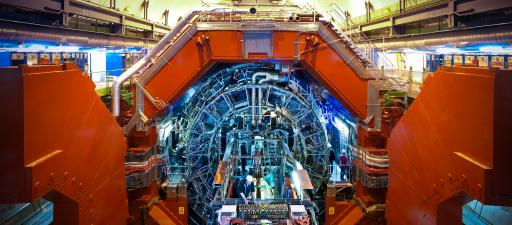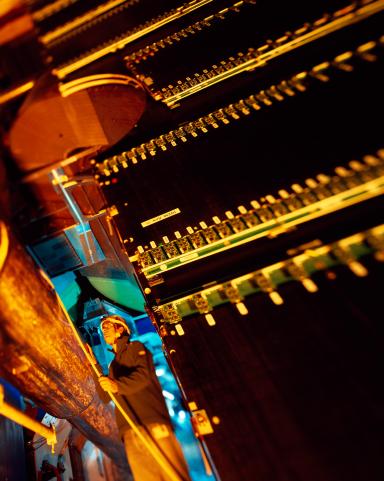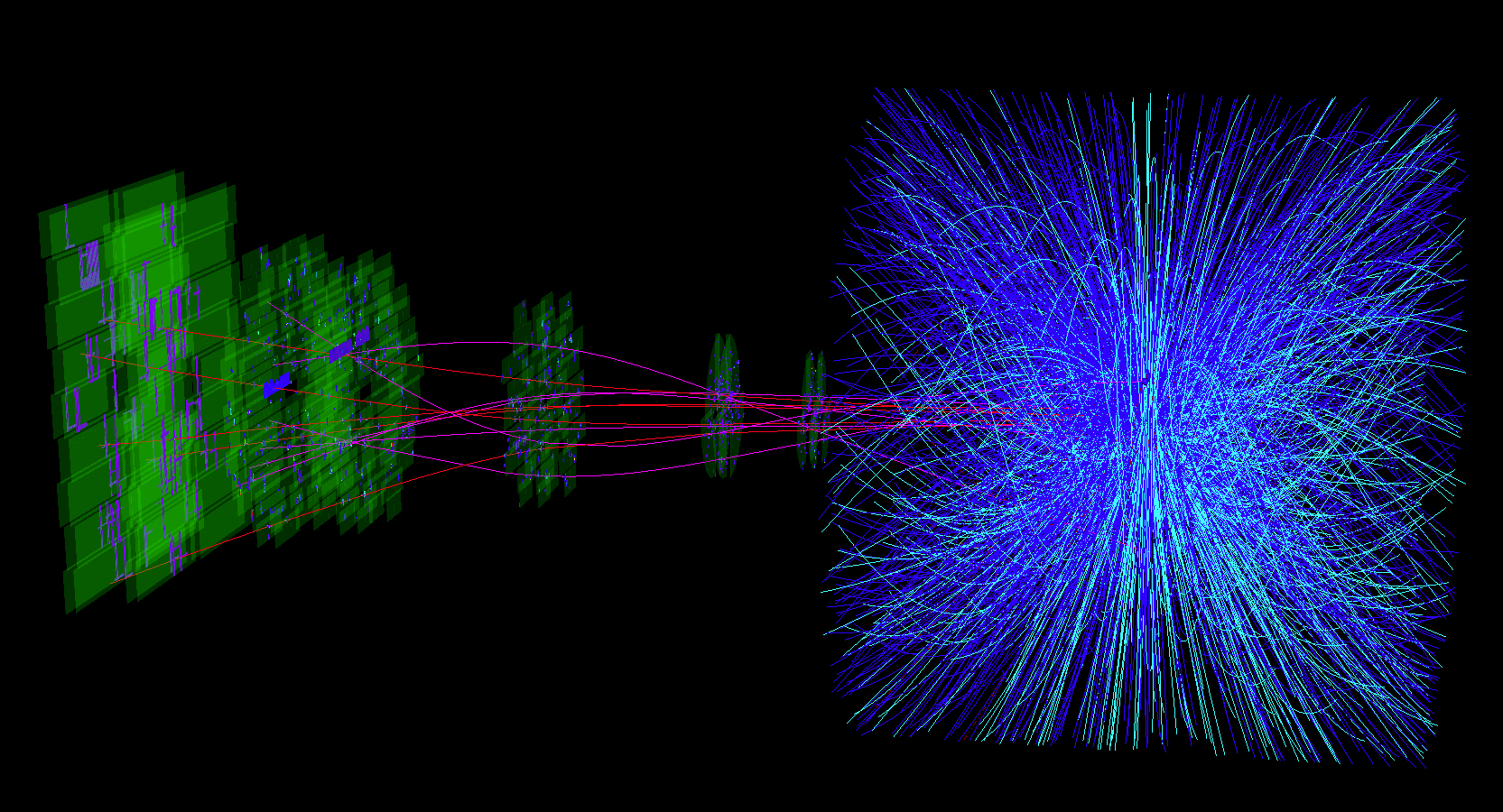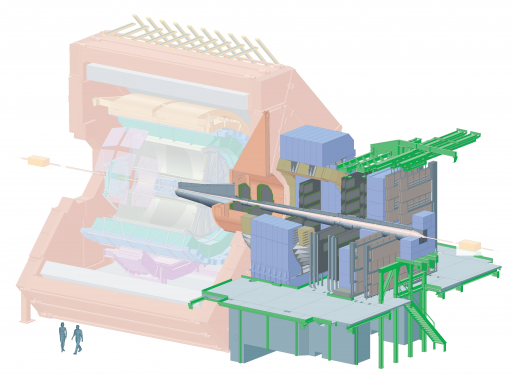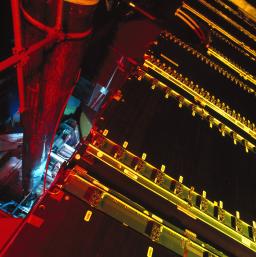The ALICE experiment is devoted to the study of nuclear matter under extreme conditions of temperature and density. It is specially designed to test the fundamental theory of the strong interaction, Quantum Chromodynamics (QCD), which predicts the existence of this new state of matter, the quark-gluon plasma (QGP).
Objectives
There are still some open question concerning the formation of our Universe. The ordinary matte of our Universe is composed of atoms formed by a nucleus, itself made of protons and neutrons, surrounded by a cloud of electrons. Protons and neutrons are themselves composed of quarks, which are to our current knowledge the elementary constituents of matter. Just after the Big Bang, during the first micro seconds of the creation of the Universe, its temperature was higher than 2000 billion degrees (about 100 000 times hotter than the centre of the Sun), the Universe was in a state of deconfined quarks and gluons: the quark-gluon plasma (QGP).
Why and how did hadrons (compounds of elementary particles) form? What are the properties of the QGP? Can we reproduce the early Universe? Those are questions ALICE tries to answer.
Ultra-relativistic heavy-ion collisions at the LHC
To recreate the conditions for the formation of the QGP, heavy ions are accelerated by the LHC at CERN near Geneva close to the speed of Light before making them to collide. ALICE is one of the four big experiments of the LHC placed at one of the crossing points of the LHC beams. ALICE was designed to reconstruct the thousands of particles created by the collision with to study the QGP created therein.
The ALICE detector
ALICE counts more than a thousand physicists and engineers, from 132 institutes in 36 different counties. ALICE is composed of 18 sub-detectors extending over a length of about 26 m and a height of 16 m, weighting over 10 000 tonnes. They are regrouped in a central part and a forward one called the muon spectrometer.
IRFU contributions
Among the different observables of the QGP, heavy resonances or quarkonia are particularly interesting. Quarkonia are rare and heavy particles composed of a pair quark and anti-quark, charm or beauty for the J/psi and Upsilon family, respectively. Quarkonia are produced at the early stage of the collision, even before the creation of the QGP, and thus experience the full evolution of the QGP that they have traversed. IRFU is particularly interested in the study of the production of quarkonia, which can be measured by its decay into a µ+µ- pair reconstructed by the ALICE muons spectrometer.
The muon spectrometer
The IRFU is thus involved in the realization of the ALICE muon spectrometer. The IRFU contributed to the design and the realization of the 5 tracking stations.
The IRFU was in charge of:
- the construction of 39 slats of detection (out of 160),
- the support pannels,
- the systems of translation of the 3 large stations and the handling and integration equipments in the cavern,
- the integration of the 3 big stations (3, 4 and 5),
- the study of the air cooling system.
Upgrade of the muon spectrometer
The make the most of the luminosity upgrade of the LHC foreseen for 2018 the electronics and read-out system of the muon spectrometer must be upgraded.
The Muon Forward Tracker (MFT)
To extend the physics program of the ALICE muon spectrometer a silicon pixel tracker will be placed between the crossing point of the LHC beams and the muon spectrometer.
Timeline
- 2003-2005: production of 39 slats
- July 2006: first half-chamber installed in the cavern
- June 2008: cavern closes
- August 2008: first particles in the ALICE V0 detector
- November 2009: first p-p collisions at 900 GeV
- March 2010: first p-p collisions at 7 TeV
- November 2010: first Pb-Pb collisions at 2.76 TeV
- March 2013: p-Pb collisions at 5.02 TeV
- April 2013: beginning of the first long shutdown of the LHC (LS1)
- 2013-2015: repairs of different components of the muon spectrometer
- Early 2015: Restart of the LHC (Run2)
- 2018: LS2
- Upgrade of the muon spectrometer
- Installation of the MFT
- ...
Contacts
Alberto BALDISSERI: Coordinator of the ALICE muon spectrometer
Hervé BOREL: Coordinator of the muon spectrometer upgrade
Fabienne ORSINI: Technical coordinator of the MFT
The IRFU contribution to the ALICE experiment focused on the largest tracking chambers of the muon spectrometer, which measures the μ+μ- pairs coming from the decay of the ϒ and J/ψ resonances.
Introduction
The muon spectrometer, which covers the polar angular range between 2° and 9°, consists of a front absorber, five tracking stations with the third one located inside a warm dipole, an iron wall and triggering chambers. Each station consist of two cathode pad chambers with pads on both sides of the gas gap in order to get correlated x-y measurement in each chamber.
The Tracking chambers
The tracking cathode pad chambers have different designs depending on their dimensions: the first two stations are made of quadrants whilst the largest chambers, with an outer diameter of up to 6 m, are made of modular detectors called “slats”, with an active area of 40 cm vertically along the wires times 80-240 cm horizontally. Each slat represents about 3% radiation length. Various sizes of the cathode pads are used in order to minimize the number of electronic channels when taking into account the decrease of the expected occupation toward large radii. The main characteristics of a slat have been validated in test beams at CERN. With an efficiency of 97%, a spatial resolution of 45 μm has been achieved in the vertical direction. These figures are well within the requirements of the dimuon arm. The construction of the 160 slats was shared between Cagliari, Gatchina, Nantes and Saclay laboratories, using same materials and assembly procedures. The construction spanned from end of 2003 to end of 2005. The Dapnia is also responsible for the slats supports, for the cooling and the integration of the tracking stations 3, 4 and 5. The slat supports are made of a honeycomb sandwich with carbon fiber skins. The use of carbon fiber ensures a good stiffness and a small thermal dilatation. The thickness of each of the 12 supports is smaller than 0.003 radiation length. The largest support is ~6 m high and ~3 m wide with a thickness of 18 mm and a planarity around 10 mm. The supports have been delivered in 2005.
Each half chamber, located on each side of the beam pipe, consists of slats mounted on one support along with services as cables and gas pipes. After two years of slat production, the chamber assembly phase gathers the slats coming from the four laboratories to test them, with high voltage, gas and final electronics read-out and mount them with the services on the support. This phase is running in an assembly hall at CERN at point 2 close to the ALICE pit, starting in spring 2006 and ending in summer 2007. Tools have been built for the handling of the supports, their hanging for mounting the slats, and the possibility to store them before their installation in the ALICE cavern. The rails on which are fixed the half-chambers allow stations 4 and 5 to be in close or open position compared to the beam pipe. The rail system of station 3 is complex and permits the delicate integration of the station inside the dipole. The SIS technical division in Dapnia designed these tools and rails. The rails were installed in fall 2006.
Electronics
The front end electronics cards (MANU cards) are plugged on the PCBs of these detectors, they consist of four MANAS chips (a preamplifier made in India) for the amplification and shaping of the analog signal, one MARC chip which controls the MANU card and makes the zero suppression and two 12 bits ADCs. We foresee to calibrate the electronics by sending a signal in situ via a calibration line. We expect a 2-3% calibration precision. Different tests have been done in order to check the whole calibration chain using the final hardware (electronics cards, readout programs, etc).
Geometry positioning
The pad position is known by construction and photogrammetry technics. First, pads are etched on PCBs (Printed Circuit Board) with an accuracy of few microns, then PCBs are assembled to form a slat with the help of a precise granite table (holes of 10 μm accuracy), finally the position of the slats compared to the supports is known by photogrammetry (~50 μm in plane and ~100 μm out of plane). The whole half-chamber is surveyed with an accuracy of 0.5-1 mm. As described previously, we took care of the material for the mechanical parts of the slats and the supports, using carbon fiber to minimize the thermal dilatation.
Towards data taking
The installation of the cables has started in January 2007 and was followed by the commissioning phase running in parallel with the assembly and installation phases. The installation will end up in summer 2007 while the commissioning will last until the closure of the cavern. A complete test of the whole tracking system is foreseen well before the data taking.
After an intensive simulation done at Saclay, an air-cooling solution has been adopted, which is quite delicate especially for the third station located in the dipole. Ducts and pipes have been designed in cooperation with CERN groups and have been installed end of 2006. The integration of the chambers in the cavern is running in parallel with the assembly. The first half-chamber of station 4 was installed in July 2006; with the muon trigger chambers, it was the first detector to be in place. The quadrant installation has started in February 2007.
Figures
For the five stations:
-five tracking stations;
-angular width: 2 to 9 degrees;
-Total detection area: nearly 90 m2 !
Stations with Dapnia involvment:
-The 3 tallest trajectography stations: stations 3, 4 et 5.
Production
Slats:
Total number of slats for Alice: 160
Number of slats produced in 2 years by the IRFU: 40
(November 2005: production ended)
• Structure of nuclear matter › Quark-gluon plasma
• The Electronics, Detectors and Computing Division • The Nuclear Physics Division • The Systems Engineering Division
• Laboratory of Mechanical Studies and Detectors Integration (LEMID)

